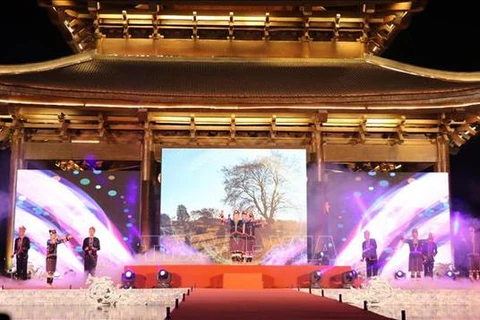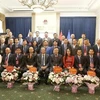 Visitors take a boat tour into Thung Nang Valley in Ninh Hai commune, Hoa Lu district, northern Ninh Binh province. (Photo: VNA)
Visitors take a boat tour into Thung Nang Valley in Ninh Hai commune, Hoa Lu district, northern Ninh Binh province. (Photo: VNA) Tuyen was among 20 people to give boat tours to visitors. The eco-tourism area was under construction and received few visitors, so she was mainly transporting experts and workers to work in the area.
Like most villagers in Hoa Lu district’s Truong Yen commune, Tuyen was struggling to earn a living with unstable income from raising rice crops. She decided to leave her field behind and try a new job, hoping things would be better.
The 40-year-old woman has nothing to regret. The eco-tourism area, known as Trang An Landscape Complex, has become a World Cultural and Natural Heritage Site, comprising well-known tourism areas in five districts and cities of Ninh Binh on an area of 12,252 hectares.
In Tuyen’s commune, the tourism facilities attract more than 100,000 tourists each year. The job has improved her income and changed her life significantly.
“My income has been stable, and I have chances to talk and learn from domestic and foreign tourists,” she said.
“Tourism brings me and many boatwomen here good things. We are determined to protect the tourist area,” she shared.
Hoang Thi Thu Huong, Deputy Head of the Management Board of Trang An Scenic Landscape Complex, said that the tourist area is creating jobs for 1,300 boat drivers, mainly women aged 45-60, with a monthly salary of 5-6 million VND (212-255 USD).
The labourers join regular training programmes to be equipped with skills and raise their awareness on the importance of tourism development.
“The area always tries to ensure a stable source of income to attract more and more local people to participate in tourism activities,” she said.
Previously, people living in Trang An Scenic Landscape Complex earned their living by farming, doing animal husbandry and handicrafts.
Tourism development has enriched the livelihoods of local residents. The economic structure is rapidly shifting from agriculture and handicrafts to services. Many have switched jobs in tourism services such as giving accommodation, boat tours, community-based travel services or opening restaurants.
Agricultural production only accounts for 15% of the economic structure of the heritage area.
Statistics from the Management Board of the Trang An Scenic Landscape Complex showed that currently, about 50,000 people are living in the heritage site. Of that, more than 14,000 are living in the core area of the complex.
The complex has created jobs for about 30,000 labourers. Local people are involved in the protection and management of heritage, and contribute ideas to develop mechanisms and policies to ensure harmony between heritage conservation and their sustainable livelihoods.
Apart from creating sustainable livelihoods for local people, tourism development has also contributed to restoring traditional cultural values that are at risk of extinction.
In 1994, only about 10 households in Ninh Hai commune made hand-embroidered products, the traditional embroidery craft of the commune, as they were ordered from handicraft export companies.
After 2014, when the Trang An Scenic Landscape Complex received World Cultural and Natural Heritage recognition, hundreds of households in the commune have turned to the traditional career due to the sharp increase in the number of tourists, especially international visitors, to the area.
Tourism activities have become an important trade promotion channel, expanding the brand name of Ninh Hai embroidery handicraft and attracting orders to purchase the products.
Currently, traditional embroidery is creating jobs for hundreds of local people.
In other communes, traditional crafts have been restored, such as fine art stone craft in Ninh Van commune. Local people can improve their income by doing traditional handicrafts or giving homestay services and tour guides for visitors.
By the end of this year, roughly 200 out of 256 accommodation services use the homestay model in Hoa Lu district.
In order to harmonise between heritage preservation and sustainable livelihoods for people in the heritage area, Vice Chairman of the Hoa Lu District People's Committee Hoang Ngoc Hoa said the committee will set up a detailed plan of residential areas in both core and buffer zones of the heritage as a basis for land and construction management and the building of tourist zones and community-based tourism sites.
The committee will accelerate investment in tourism facilities and develop policies to support people in building high quality agricultural production models associated with tourism development.
Labourers will be trained to improve skills and knowledge of tourism, foreign languages and a sense of hospitality and politeness in communication.
This will help maintain traditional livelihoods and create new money-earning methods for local people while preserving and developing the value of the heritage, he said./.
VNA
























